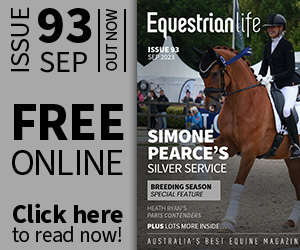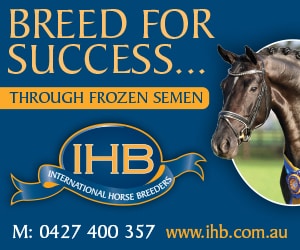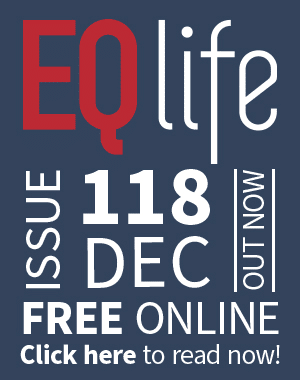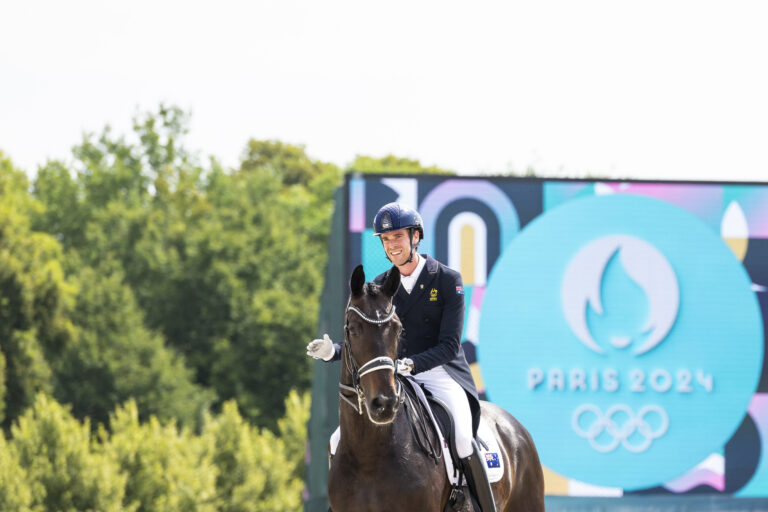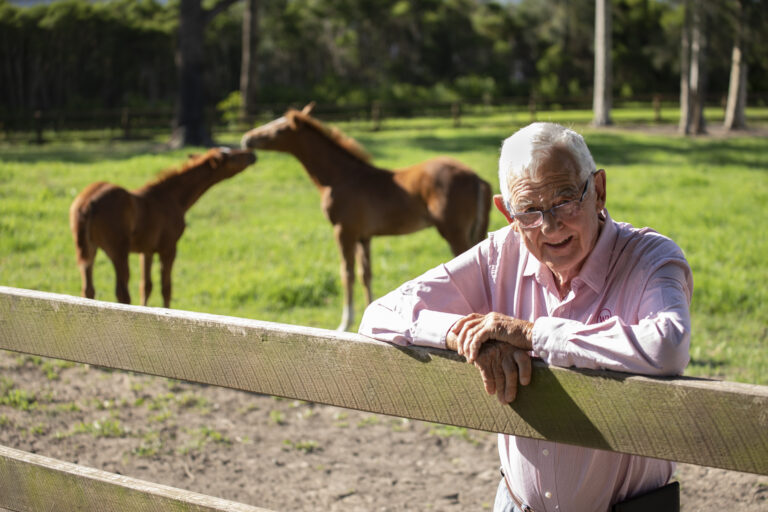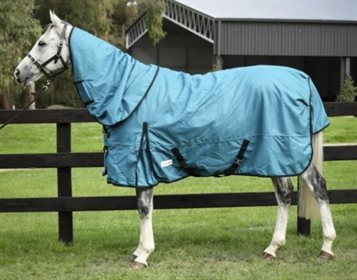This article first appeared in a previous edition of Equestrian Life magazine. To see what is in our latest digital issue, please click here.

It is essential for survival that the foal is strongly attached to his mother.
Horses and attachment
By Dr Kerry Mack
Have you had the joy of raising a foal? Within minutes of birth they are up on their spindly legs, nuzzling the mare for milk. It is essential for survival that the foal is strongly attached to his mother. He must return to her not only for milk, but when he is unsafe or unsure. She must function as a secure base for his explorations, a haven for him to go to if something threatens.
Horses are programmed for attachment, a connection with another being, something that hasn’t been thought about much by riders and trainers. This is true for all baby mammals, including humans. The hormone oxytocin drives this biologically determined connection. We are all now accept that horses are a herd animal, programmed to accept leadership. We know that the rider/trainer should be the leader of the herd, as it were. It is also relevant to think of the rider/trainer as an attachment figure, that the horse should be able to experience the rider as someone who can provide it with a secure base and safe haven. For example, a horse exposed to a new stress such as a horse float, a loud competition stadium, or a novel cross-country obstacle, will benefit from experiencing the rider as someone who helps him know the strange thing is safe, not just experiencing the person as the boss or leader of the pack.
We know a great deal about the qualities of secure attachment in humans. We can learn from this and how we can use this knowledge to inform and even evaluate the quality of our training and the relationship with our horse. Does your horse experience you as someone who makes the world feel safer? Or does he experience you as someone who actually may attack or persecute him when he seeks safety? Are you someone he wants to be near when he is frightened, or is he likely to be afraid of your response if something frightens him? I have seen horses respond to stress in a way that I think the relationship they have with the rider is as a perpetrator of abuse. He becomes frightened of something, and then becomes frightened of the reaction of the rider, acting as if he wants to run away from the rider as well. None of us want that relationship, however, sometimes we act in a way that leads to this.
In recent articles we have been exploring the stress response in horses and riders. We can recognise the responses of fight, flight and freeze. There is another response we describe as cry for help. This is a psychological, not physiological, response to stress. It is ingrained into most of us to cry for help (or seek out or long for) when stressed or afraid. This is a response based on the attachment we have with our mothers. Ethology predicts that all mammals will experience attachment to a primary carer (mother with a milk supply). Studies have been done with all kinds of animals, even rats, demonstrating attachment. The fact that horses show separation anxiety when removed from a friend (most often horse, but sometimes human or other) also shows us that attachment theory is relevant to us as horse trainers.
Ethology is the scientific study of behaviour of animals, often relating it to evolution and survival strategies. Understanding ethology can help in animal training. Ethology started in the 1930s with the Nobel Prize-winning work of Niko Tinbergen, Konrad Lorenz and Karl von Frisch. Konrad Lorenz studied Greylag geese and found that there was a critical period when the geese would imprint on to the first moving animal they saw. He separated eggs into two groups and found that goslings would follow him if he was the first thing they saw and would prefer him to their genetic mother when given a choice! Harlow’s studies with monkeys showed that when a baby monkey was offered a choice between a cuddly artificial surrogate mother (a wire frame covered in wool), and a wire surrogate mother with a milk bottle attached, it would choose the cuddly one and starve, so great is the need for comfort
By the 1950s, British paediatrician and psychiatrist John Bowlby was developing his theories of attachment, drawing on some of the ethological studies on primates, as well as his own observations. It is obvious now that for mammals (animals whose young drink milk) there is a great survival value in the infant being attached to its mother. Infant mammals, including humans, will recognise and prefer their own mothers immediately at birth; they want to be close to their mothers and will seek them out, especially if they are frightened or stressed. We say that a securely attached infant will use its mother as a secure base for exploration, and a safe haven when stressed. Those of you who have had foals will recognise this attachment behaviour, connection seeking, in them. Attachment theory is a theory explaining motivation and behaviour control.
At Mayfield, we capitalise on this reaction when teaching foals to yield to the pressure of leading. We tie the foals to their mother initially. Of course they resist the pressure of the neck collar and pull back away from the mare, but when they yield to pressure they get closer to their mothers and this is very rewarding for them (calming, restoring a sense of safety). A frightened foal calms when nearer its mother. A few repetitions of this and foals quickly learn to lead from a roller on their mothers. Having learned to yield to pressure this way it’s easy to get them to lead with a person. I believe this method is less stressful for foals and certainly prevents injuries to foals and handlers.
It is reasonable to think that a stressed horse will also have a cry for help reaction to stress. He will want someone to help sort out the danger. He will benefit from a relationship with a benevolent (bigger, stronger, wiser, kind) attachment figure who can help. This should be the rider/handler. Now, this is a slightly different slant on what we are already familiar with, that horses are a herd animal and that the human should be like a herd leader. Certainly that makes sense. The leader of the herd shows the way (actually, horses often lead from behind, as befitting a prey animal, but that’s a different story). We can understand differences in personality and behaviour of horses in terms of their dominance or submissiveness in a herd. In addition, I propose that a stressed horse may seek proximity to and be calmed by a trusted attachment figure. He seeks a connection to someone who can help him. Of course, if you are the rider of a stressed horse you are already in proximity with him. I think that if the rider/handler brings the attributes that we know are associated with secure attachment to the relationship with the horse, things are likely to go more smoothly.
We know that “good enough” parents, those with whom a baby can become securely attached, will be reliable, responsive, reciprocal, and sensitive. Good-enough parents will follow whenever possible, take control whenever necessary. They will be bigger, stronger, wiser and kind*. They will help organise the experience of the infant into manageable chunks. They will not perpetrate trauma on a frightened infant. They will not usually project their own feelings on to a child, but will have a sense of the actual experience of the child based on the capacities and characteristics of the child. These attributes of a good-enough mother are attributes I think we should try to embody as horse trainers. We want the horse to experience us as bigger and stronger, metaphorically, wiser and kind. We want the horse to feel safe around us. We can introduce new things to him gradually, like we do with breaking in. We can develop empathy for the horse by understanding his actual capacity and sensory experience (see previous article on empathy). We should take into account when he is genuinely frightened and adjust what we do accordingly.
There is a balance between being the leader and being bigger, stronger, wiser and kind, the characteristics of a safe attachment figure. It is possible to think that being the leader of the herd embodies a generally masculine attitude and being a secure attachment figure embodies a more generally feminine attitude. Yin and yang, balancing complementary characteristics. Perhaps an idea to explore another time.
READ THE LATEST NEWS ARTICLES HERE
